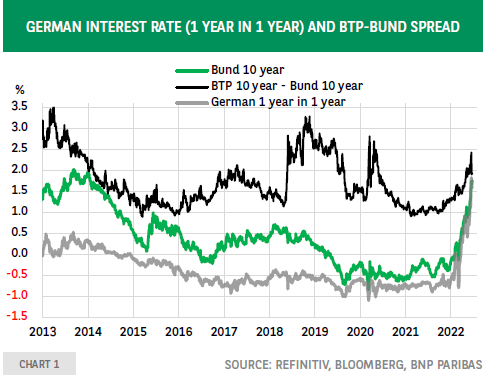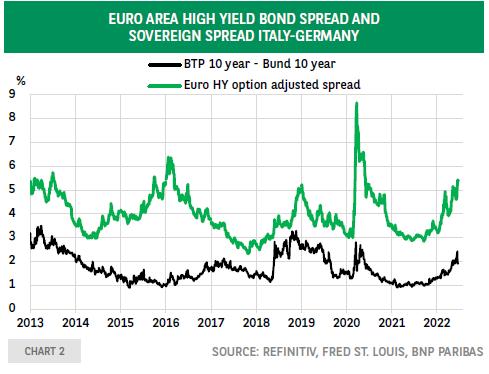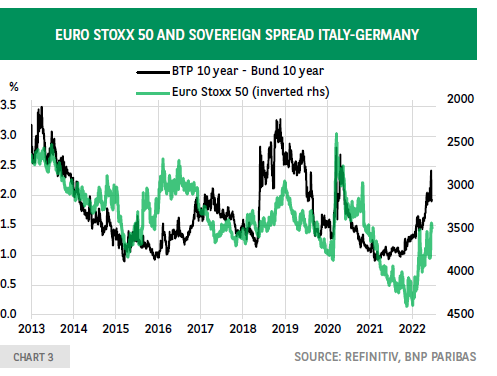A lasting, unwarranted widening of sovereign spreads in the euro area would represent an excessive tightening of financial conditions and weigh on activity and demand. It would run into conflict with the objectives of the ECB in the context of its monetary policy normalisation. Spreads are influenced by various fundamental variables that are directly or indirectly related to debt sustainability issues. These tend to be slow-moving. Sovereign spreads also depend on the level of risk aversion, a variable that fluctuates a lot and which is influenced by global factors. This complicates the assessment of whether an observed spread widening is warranted or not.
The recent, significant widening of sovereign spreads in the euro area has triggered a renewed interest in the drivers of the difference between government bond yields in a given country and the yield on German government bonds of equivalent maturity. This interest is influenced by comments from ECB governing council members about the need to address unwarranted spread widening.
Putting a number on ‘unwarranted’ is a huge challenge considering that the sovereign spread depends on several variables. Moreover, the relationship – the beta in statistical terms – is time-varying. When Bund yields rise, the spread between Italian and German government bonds – the BTP-Bund spread – often widens but sometimes the opposite happens. Recently, the relationship has been positive and increasingly so1. The prospect of higher policy rates has played an important role. As shown in chart 1, the rise of the one-year forward rate of German government paper with a maturity of one year – a measure of monetary policy expectations – to a very large degree corresponds with the increase in 10-year Bund yields and both series are highly correlated with the rise in the BTP-Bund spread.
From a Finance theory perspective, one would indeed expect a positive beta between German rates and sovereign spreads. When the riskfree rate increases, a smaller exposure to riskier assets is needed to meet the target return. Macroeconomic theory also sees a positive relationship but for another reason: higher interest rates influence the debt sustainability parameters. Indeed, supposing that the debt ratio was initially stable, a permanent increase in the average borrowing cost would require, ceteris paribus, a reduction in the public sector primary deficit or a smaller primary surplus to keep the debt ratio stable2. Especially in case of a lasting, significant increase in interest rates, there may be concern that measures taken to stabilize the debt ratio would be slow or insufficient. Such concern would be reflected in a higher spread.
ECB research3 for the period 1999-2010 shows that in the euro area4 the public sector balance and the debt ratio play a statistically significant role in explaining the behaviour of sovereign spreads. The latter are positively correlated with financial risk, represented by the VIX index. Slower growth, an appreciation of the real exchange rate or a decline in bond market liquidity are associated with a widening of spreads. Credit ratings are significant but their influence is small. Importantly, during the European sovereign debt crisis, the sensitivity of bond prices to fundamentals increased. More recent research comes to similar conclusions on these variables and identifies the role of QEmeasures in influencing spreads.5 Jordi Paniaguaa et al6 emphasize that market sentiment and hence spreads also depend on differences in output growth between core and peripheral countries. This argues for macroeonomic policy coordination to enhance convergence within the Eurozone. Research by the IMF7 highlights the role of global risk aversion in the behaviour of spreads. Between July 2007 and September 2008 – a period that the authors call the financial crisis build-up – Germany and other core countries benefitted from flight-to-quality flows whereas risk aversion was weighing adversely on peripheral countries.
Spreads are influenced by slow-moving fundamental variables that are directly or indirectly related to debt sustainability issues but also by short-term fluctuations in risk aversion. This complicates the assessment of whether an observed spread widening is warranted or not.
To illustrate the role of risk aversion, charts 2 and 3 compare the evolution of the BTP-Bund spread and, respectively, the euro high yield spread and the Euro Stoxx 50 equity index. Recently, the correlation between the sovereign spread and the high yield spread has been high and this also applies to the sovereign spread and equity market developments. This suggests that in recent months, risk aversion has increased, probably on the back of a prospect of higher ECB policy rates and a more uncertain growth outlook, in relation with elevated inflation and the war in Ukraine.
To conclude, spreads are influenced by various fundamental variables that are directly – public balance, debt – or indirectly economic growthrelated to debt sustainability issues. These tend to be slow-moving. Sovereign spreads also depend on the level of risk aversion, a variable that fluctuates a lot and which is influenced by global factors. This complicates the assessment of whether an observed spread widening is warranted: it may be unwarranted based on the (expected) evolution of the fundamentals whilst making sense in an environment of rising risk aversion.
BNP Paribas is regulated by the FSA for the conduct of its designated investment business in the UK and is a member of the London Stock Exchange. The information and opinions contained in this report have been obtained from public sources believed to be reliable, but no representation or warranty, express or implied, is made that such information is accurate or complete and it should not be relied upon as such. This report does not constitute a prospectus or other offering document or an offer or solicitation to buy any securities or other investment. Information and opinions contained in the report are published for the assistance of recipients, but are not to be relied upon as authoritative or taken in substitution for the exercise of judgement by any recipient, they are subject to change without notice and not intended to provide the sole basis of any evaluation of the instruments discussed herein. Any reference to past performance should not be taken as an indication of future performance. No BNP Paribas Group Company accepts any liability whatsoever for any direct or consequential loss arising from any use of material contained in this report. All estimates and opinions included in this report constitute our judgements as of the date of this report. BNP Paribas and their affiliates ("collectively "BNP Paribas") may make a market in, or may, as principal or agent, buy or sell securities of the issuers mentioned in this report or derivatives thereon. BNP Paribas may have a financial interest in the issuers mentioned in this report, including a long or short position in their securities, and or options, futures or other derivative instruments based thereon. BNP Paribas, including its officers and employees may serve or have served as an officer, director or in an advisory capacity for any issuer mentioned in this report. BNP Paribas may, from time to time, solicit, perform or have performed investment banking, underwriting or other services (including acting as adviser, manager, underwriter or lender) within the last 12 months for any issuer referred to in this report. BNP Paribas, may to the extent permitted by law, have acted upon or used the information contained herein, or the research or analysis on which it was based, before its publication. BNP Paribas may receive or intend to seek compensation for investment banking services in the next three months from an issuer mentioned in this report. Any issuer mentioned in this report may have been provided with sections of this report prior to its publication in order to verify its factual accuracy. This report was produced by a BNP Paribas Group Company. This report is for the use of intended recipients and may not be reproduced (in whole or in part) or delivered or transmitted to any other person without the prior written consent of BNP Paribas. By accepting this document you agree to be bound by the foregoing limitations. Analyst Certification Each analyst responsible for the preparation of this report certifies that (i) all views expressed in this report accurately reflect the analyst's personal views about any and all of the issuers and securities named in this report, and (ii) no part of the analyst's compensation was, is, or will be, directly or indirectly, related to the specific recommendations or views expressed herein. United States: This report is being distributed to US persons by BNP Paribas Securities Corp., or by a subsidiary or affiliate of BNP Paribas that is not registered as a US broker-dealer, to US major institutional investors only. BNP Paribas Securities Corp., a subsidiary of BNP Paribas, is a broker-dealer registered with the Securities and Exchange Commission and is a member of the National Association of Securities Dealers, Inc. BNP Paribas Securities Corp. accepts responsibility for the content of a report prepared by another non-US affiliate only when distributed to US persons by BNP Paribas Securities Corp. United Kingdom: This report has been approved for publication in the United Kingdom by BNP Paribas London Branch, a branch of BNP Paribas whose head office is in Paris, France. BNP Paribas London Branch is regulated by the Financial Services Authority ("FSA") for the conduct of its designated investment business in the United Kingdom and is a member of the London Stock Exchange. This report is prepared for professional investors and is not intended for Private Customers in the United Kingdom as defined in FSA rules and should not be passed on to any such persons. Japan: This report is being distributed to Japanese based firms by BNP Paribas Securities (Japan) Limited, Tokyo Branch, or by a subsidiary or affiliate of BNP Paribas not registered as a financial instruments firm in Japan, to certain financial institutions permitted by regulation. BNP Paribas Securities (Japan) Limited, Tokyo Branch, a subsidiary of BNP Paribas, is a financial instruments firm registered according to the Financial Instruments and Exchange Law of Japan and a member of the Japan Securities Dealers Association. BNP Paribas Securities (Japan) Limited, Tokyo Branch accepts responsibility for the content of a report prepared by another non-Japan affiliate only when distributed to Japanese based firms by BNP Paribas Securities (Japan) Limited, Tokyo Branch. Hong Kong: This report is being distributed in Hong Kong by BNP Paribas Hong Kong Branch, a branch of BNP Paribas whose head office is in Paris, France. BNP Paribas Hong Kong Branch is regulated as a Licensed Bank by the Hong Kong Monetary Authority and is deemed as a Registered Institution by the Securities and Futures Commission for the conduct of Advising on Securities [Regulated Activity Type 4] under the Securities and Futures Ordinance Transitional Arrangements. Singapore: This report is being distributed in Singapore by BNP Paribas Singapore Branch, a branch of BNP Paribas whose head office is in Paris, France. BNP Paribas Singapore is a licensed bank regulated by the Monetary Authority of Singapore is exempted from holding the required licenses to conduct regulated activities and provide financial advisory services under the Securities and Futures Act and the Financial Advisors Act. © BNP Paribas (2011). All rights reserved.
Recommended Content
Editors’ Picks
EUR/USD edges lower toward 1.0700 post-US PCE

EUR/USD stays under modest bearish pressure but manages to hold above 1.0700 in the American session on Friday. The US Dollar (USD) gathers strength against its rivals after the stronger-than-forecast PCE inflation data, not allowing the pair to gain traction.
GBP/USD retreats to 1.2500 on renewed USD strength

GBP/USD lost its traction and turned negative on the day near 1.2500. Following the stronger-than-expected PCE inflation readings from the US, the USD stays resilient and makes it difficult for the pair to gather recovery momentum.
Gold struggles to hold above $2,350 following US inflation

Gold turned south and declined toward $2,340, erasing a large portion of its daily gains, as the USD benefited from PCE inflation data. The benchmark 10-year US yield, however, stays in negative territory and helps XAU/USD limit its losses.
Bitcoin Weekly Forecast: BTC’s next breakout could propel it to $80,000 Premium

Bitcoin’s recent price consolidation could be nearing its end as technical indicators and on-chain metrics suggest a potential upward breakout. However, this move would not be straightforward and could punish impatient investors.
Week ahead – Hawkish risk as Fed and NFP on tap, Eurozone data eyed too

Fed meets on Wednesday as US inflation stays elevated. Will Friday’s jobs report bring relief or more angst for the markets? Eurozone flash GDP and CPI numbers in focus for the Euro.


